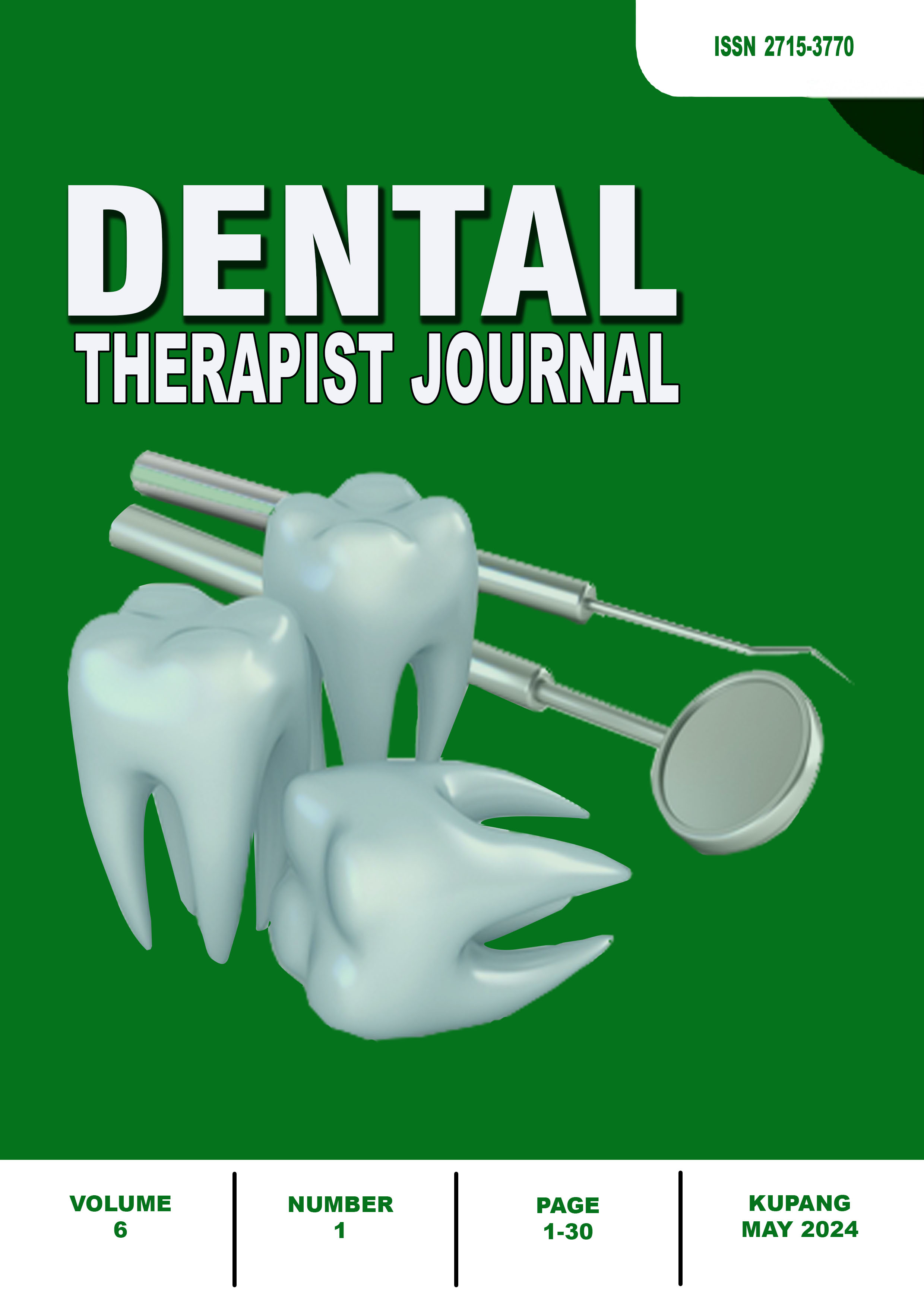The Discipline of Tooth Brushing on Caries Prevalence in Children
DOI:
https://doi.org/10.31965/dtj.v6i1.1406Keywords:
Discipline, Tooth Brushing, Control Card, Caries PreventionAbstract
Indonesian people's brushing habits are still very concerning, as seen from the 2018 Basic Health Research data where only 2.3% of the population aged ≥ 10 years brushed their teeth after eating breakfast and before going to bed at night. This study aimed to determine the effect of tooth brushing discipline on the prevalence of caries in children of SD Negeri 2 Baumata Timur, Kupang Regency. This study is an experiment with a one-shot case study design, without a control group conducted on all 130 SDN 2 Baumata Timur students. All respondents were given an initial examination to determine dental caries (def-t/DMF-T) and were educated on brushing their teeth properly. Respondents were given control cards and stickers to be attached to the column after brushing their teeth in the morning after eating and the column brushing their teeth before going to bed at night for 120 effective days. Respondents will be evaluated for dental caries by re-examining dental caries (def-t/DMF-T) after brushing their teeth for 120 days, this aims to determine whether there are new caries after routine brushing activities carried out by the response. The results showed that the behavior of brushing teeth that was carried out consistently or the discipline of children brushing their teeth for 120 days by students at home was in the morning after eating and at night before going to bed. The results of the evaluation of dental caries after the intervention on regular brushing habits using oral health control cards showed that there was no risk of caries or new caries during 120 days of regular and consistent brushing. The results of the Wilcoxon Signed Ranks Test statistical test showed a significant value of p 1.000> 0.05, so there was no difference before and after treatment using a dental health control card, but in substance there was an effect on caries prevention. The conclusion is that the discipline or consistency of children in brushing their teeth in the morning after eating and at night before bed can prevent dental caries in children.
References
Alhamda, S. (2011). Status kebersihan gigi dan mulut dengan status karies gigi (kajian pada murid kelompok umur 12 tahun di sekolah dasar negeri kota bukittinggi). Berita kedokteran masyarakat, 27(2), 108-115.
Anggow, O. R., Mintjelungan, C. N., & Anindita, P. S. (2017). Hubungan pengetahan kesehatan gigi dan mulut dengan status karies pada pemulung di tempat pembuangan akhir Sumompo Manado. e-GiGi, 5(1).
Cahyaningrum. (2017). Hubungan perilaku ibu terhadap kejadian karies gigi pada balita di paud putra sentosa. Jurnal Berkala Epidemiologi, 5(2), 142-151.
Chairunnisa, N. S., Sirait, T., Supriyanto, I., & Nurjanah, N. (2023). Description of knowledge levels about the maintenance of dental and oral health with the occurrence of dental caries in class VI at SDN Sindangbarang 2. Jurnal Terapi Gigi dan Mulut, 2(2), 116-121. https://doi.org/10.34011/jtgm.v2i2.1402
Factarun, S. (2018). Hubungan Motivasi dan Perilaku Menggosok Gigi dengan Karies Gigi pada Anak Usia Sekolah di MI NU Islahussalafiyah Kudus. Prosiding HEFA (Health Events For All).
Fifiana, S. Y., Hidayati, S., & Larasati, R. (2023). Gambaran Pengetahuan Tentang Karies Gigi Siswa Sekolah Dasar. Indonesian Journal of Health and Medical, 3(4), 89-104.
Hardika, B. D. (2018). Hubungan pengetahuan dan sikap anak kelas v terhadap terjadinya karies gigi di SD Negeri 131 Palembang. Jurnal Kesehatan Saelmakers PERDANA (JKSP), 1(2), 111-115.
Haryanti, D. D., Adhani, R., Aspriyanto, D., & Dewi, I. R. (2014). Efektivitas menyikat gigi metode horizontal, vertical, dan roll terhadap penurunan plak pada anak usia 9-11 tahun. Dentino Jurnal Kedokteran Gigi, 2(2), 150-154.
Imamah, N., Ningsih, N. S., & Abral, A. (2022). Differences in Dental Caries Rates Based on Tooth Brushing Time: Perbedaan Angka Karies Gigi Berdasarkan Waktu Menyikat Gigi. Ahmar Metastasis Health Journal, 1(4), 168-174. https://doi.org/10.53770/amhj.v1i4.151
Kementerian Kesehatan Republik Indonesia. (2013). Riset Kesehatan Dasar (Riskesdas) 2013. Badan Penelitian dan Pengembangan Kesehatan.
Maulidta, K. W., & Hastuti, S. (2017). Hubungan Kebiasaan Menggosok Gigi dan Konsumsi Makanan Jajanan Kariogenik dengan Kejadian Karies Gigi pada Anak Usia Prasekolah Di Taman Kanak-Kanak Pondok Beringin Semarang. Jurnal Ilmu Dan Teknologi Kesehatan, 1(1).
Nainggolan, S. J. (2019). Gambaran Pengetahuan Anak Tentang Jenis Makanan Kariogenik Terhadap Terjadinya Karies Gigi Pada Siswa/i Kelas VB SD Negeri 068003 Kayu Manis Perumnas Simalingkar Medan Tuntungan. Jurnal Ilmiah PANNMED (Pharmacist, Analyst, Nurse, Nutrition, Midwivery, Environment, Dentist), 14(1), 110-114.
Purnama, T., Ngatemi, N., Sofian, R., Kasihani, N. N., RE, P. R., & Nurbayani, S. (2020). Model 5 Days Gosgi sebagai upaya pembentukan kemandirian menggosok gigi anak usia dini di sekolah. Quality: Jurnal Kesehatan, 14(1), 19-24.
Santi, A. U. P., & Khamimah, S. (2019). Pengaruh Cara Menggosok Gigi terhadap Karies Gigi Anak Kelas IV Di SDN Satria Jaya 03 bekasi. SEMNASFIP, 47-51. Retrieved from https://jurnal.umj.ac.id/index.php/SEMNASFIP/article/view/5109
Variani, R., Obi, A. L. ., Manu, A. A. ., Sidabutar, M. ., & Bengu, R. . (2022). Overview of the Performed Treatment Index (PTI), Knowledge and Attitude towards Dental Cavity Treatment in Class IV and V Students at Oeletsala Elementary School, Kupang Regency: Gambaran Angka Performed Treatment Index (PTI), Pengetahuan Dan Sikap Terhadap Perawatan Gigi Berlubang Pada Murid Kelas IV Dan V Di SD Oeletsala Kabupaten Kupang. Ahmar Metastasis Health Journal, 2(1), 16–21. https://doi.org/10.53770/amhj.v2i1.99
Widi, E. R. (2003). Hubungan perilaku membersihkan gigi terhadap tingkat kebersihan mulut siswa sekolah dasar negeri wilayah kerja puskesmas gladak pakem kabupaten jember. Journal Kesehatan Gigi Indonesia, 10(3), 10-13.
World Health Organization. (2013). Oral Health Surveys: Basic Methods (5th ed.). France: World Health Organization. Retrieved from https://cappmediaprodst.blob.core.windows.net/media/1016/who-oral-health-surveys-basic-methods-5th-ed.pdf











